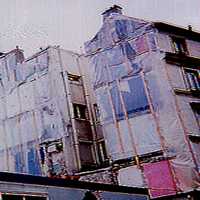demolition
september 25, 2002.
 |
 |
 |
In 1911 the Dutch painter Piet Mondriaan (1872-1944) for the first time saw cubist paintings by Braque and Picasso, at an exhibition at the Amsterdam 'Moderne Kunst Kring' (Modern Art Circle). Braque and Picasso at the time were living in Paris, and Mondriaan (he later on usually signed his name 'Mondrian') decided to move there too.
Some time ago, while glancing through the catalogue of the 1994/96 Dutch/American
retrospective of his work, I learned how Mondriaan during this first,
two years, stay in Paris got inspired by the Parisian 'urban landscape'.
He made, for example, several sketches of the walls remaining where appartment
buildings were being demolished in the middle of a block, with all the remaining
traces: painting on the walls, wallpaper, the diagonal lines where the staircase
used to be ...
It was the beginning of a long and obsessively stubborn reaching out for - and living of - a 'new esthetics', that some thirty years later came to end within the confines of another 'urban landscape', that of New York City ('Broadway Boogie Woogie').
His 'Composition No.VI / Compositie 9 / Blauwe façade' is based on one of those Parisian 'demolition wall' drawings.
This afternoon in the rue Raymond du Temple, opposite the Château
de Vincennes, I passed by just such a 'hole in the street'.
I've seen them before, of course, - and I guess most of you have too. And
they probably always have intrigued you, just as they did me.
But now that I know this little fact about Mondriaan, I somehow do
see them differently.

review
september 23, 2002.
... of the Sound Chronicles, by n_a_o of the 'SySTeM-DeLTA' electrociens, from Osaka, Japan, over at the mymp3network site:
"The collage Paris to Amsterdam. Fusion of street noise and rehearsal music of the brass. I heard it first. Allthough these were interesting but to consider to a little tedious thing. However, by hearing it repeatedly several times showed that they were those to which the expression and meaning are changed by the posture which we hear. Was it that to which from [ of whether the recording by warkman stored here is what was made in what situation ] were carried out [ sound / each ] something, or how was the scenery there sure enough? ... If those elements are made to commit imaginative power carefully, the light of these tracks will increase. By the way, it may overlap, a color may be made to sometimes discolor (then, probably, it is), and the outline of the intention may also be visible. It is unconscious, and when [ entire in a bed ] hearing it, it is reversed and these change expression. My taste is driven by the impulse which wants to carry still more popular loop on this. But I also understand the idea that, this simplicity just have a meaning."
[ Related SB-entry: each music is smart ]